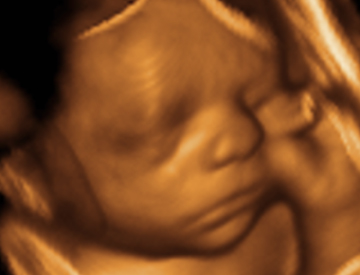Our babies love to look at us and follow us with their eyes. One of the first skills they learn is to return our smile. Now a new study published in Current Biology on June 8, 2017, shows us that the preference for other human faces is present before a child has even been born.
In the study, researchers watched how 39 fetuses in the third trimester responded when upright and inverted face-like stimuli were presented to them using light. With a 4D ultrasound they were able to see clearly how the fetuses responded. Two patterns of three dots in a triangle formation were shown as eyes and mouth and then upside down. The fetuses turned their heads to follow the upright images significantly more often than the inverted images. The results were in line with similar studies performed with infants after birth. This indicates that preborn children can differentiate between stimuli that resemble a human face and those that do not.
“We have shown the fetus can distinguish between different shapes, preferring to track face-like over non-face-like shapes,” said psychologist Vincent Reid of Lancaster University in the United Kingdom, a co-author of the study. “This preference has been recognized in babies for many decades, but until now exploring fetal vision has not been attempted.”
Reid said that this shows that the preborn child is “not just a passive processor of environmental information. It’s an active responder.” According to The Atlantic:
[Reid’s] team is now checking if fetuses share other infant biases, like a fondness for biological motion—movements that resemble those of living things. He also wants to know if they have a number sense, and can tell the difference varying quantities of dots.
In the third trimester, a human fetus can open and close his eyes and blink. He is also practicing breathing to prepare for life outside the womb. We have known that fetuses can hear, feel pain, and respond to light, but learning that they respond to the human face while having never seen one is a remarkable finding that further proves the humanity of the preborn child – constantly developing and growing just as humans are doing outside the womb.
“We could also test whether they imitate facial expressions, such as poking out the tongue, as newborns do,” Elizabeth Simpson, a child psychologist from the University of Miami told The Atlantic. “And we could also assess if fetuses, like newborns, integrate information from multiple senses—whether they look longer at matching audio-visual stimuli than at mismatching ones.”
The study concluded that experiences after birth are not necessary for the development of a “preferential visual system” for human faces. It also allowed researchers to rule out rapid postnatal learning such as imprinting as baby chicks do.
Now that we have learned that the fetus’s visual perception is more advanced than we had imagined, we can explore what else the human fetus is more advanced at than previously thought, and exactly how much that preborn person perceives within the womb. It leaves one to wonder what other postnatal experiences are unnecessary for skills we acquire in our lives, and of just how much a preborn child is aware.








